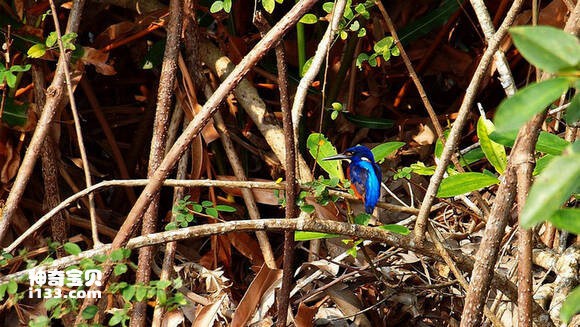Alcedo euryzona
IUCN
LCBasic Information
Scientific classification
- name:Alcedo euryzona
- Scientific Name:Alcedo euryzona,Blue-banded Kingfisher
- Outline:Climbing birds
- Family:
Vital signs
- length:About 17 cm
- Weight:34-49g
- lifetime:No textual research information is available
Feature
The male blue-banded kingfisher has a black back plumage with a chain of turquoise blue feathers
Distribution and Habitat
The Blue striped kingfisher is endemic to Southeast Asia and is found in Myanmar, Thailand, the Malay Peninsula, Indonesia, Sumatra, Java and Borneo. Rare in Burma and Thailand.
It is native to Borneo and has scrub or open forests, clear and slow-flowing rivers, streams, lakes, and irrigation canals. It is common along streams and small virgin rainforest rivers, especially in the upper reaches and tributaries of some rivers. In forested areas, it has also been observed. The range is 100 meters. At 1,250 meters above sea level, it is a rare sight at 1,500 meters on the island of Java in Borneo. It can also be seen in mangroves near streams up to 850 metres high in Malaysia. Settled, but only in Sumatra.
Appearance
The blue banded kingfisher is 17 cm long and weighs 34-49 grams. The male blue-banded kingfisher has a black back plumage with a chain of turquoise blue feathers. A large white patch on the back of the neck and under the cheeks. The thorax and abdomen are orange, with striking azure patches on the shoulder blades and on the tail and wings, in stark contrast to the black body. The legs are orange and the irises are dark brown. The female's plumage is dark brown without a blue band. The thorax, abdomen, neck, tail and wings are orange-red. The jaw is dark gray-black, the lower part reddish orange.
Mouth thick straight, long and firm, mouth ridge round; No nasal furrow; The wingtip is long, the first primary feathers are slightly shorter, and the third and fourth feathers are longest; Tail short round; The body feathers are showy and luminous, often blue or green. The head is large, the neck is short, the wings are short and round, and the tail is mostly short; The mouth is long a
Details
Alcedo euryzona, also known as the Blue-banded Kingfisher, has two subspecies (1. The subspecies Alcedo euryzona euryzona is found in Java. 2. The Borneo subspecies Alcedo euryzona peninsulae is found in Myanmar, Sumatra, Thailand and Borneo.)

Blue belt kingfisher lonely, usually live alone on the branches or rocks near the water, waiting for the opportunity to hunt, food mainly to small fish, and eat crustaceans and a variety of aquatic insects and larvae, but also pecking small frogs and a small number of aquatic plants. When a kingfisher plunges into the water, it can also maintain excellent vision because its eyes can quickly adjust the contrast in the Angle of view caused by the light in the water. So the fishing ability is very strong.

The blue banded kingfisher nests on earth cliffs or in the banks of fields and streams, using its beak to dig tunnle-like burrows, which are generally unfoiled. The eggs are laid directly on the nest ground. Each clutch lays 6-7 eggs. Egg color pure white, bright, slightly spotted, about 28 mm ×18 mm in size, 1-2 broods per year; The incubation period is about 21 days, and the eggs are incubated by both sexes, but only fed by the female.
The blue ribbon kingfisher is mainly confined to lowland forests near rivers, so it is suspected that the species is in rapid and continuous decline, as a result of the loss and destruction of habitats and entire habitats.
Listed on the International Union for Conservation of Nature (IUCN) 2012 Red List of Threatened Species ver 3.1 - Vulnerable (VU).
Protect wild animals and eliminate wild meat.
Maintaining ecological balance is everyone's responsibility!








